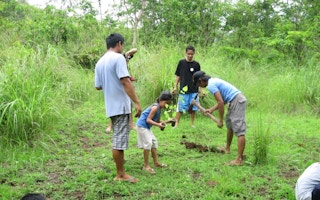Tree planting is a popular strategy for reducing carbon in the atmosphere to help combat global warming. But is it being thought through sufficiently? I think not.
In recent years, the neighborly act of planting a tree in the backyard has morphed into major geoengineering projects marketed as key interventions for managing global carbon. Important examples are the Bonn Challenge, started in 2011, which set out to plant 3.5 million square kilometres (1.4 million square miles) of trees by 2030, and the United Nations’ Billion Tree Campaign.
Africa has been targeted by the Bonn Challenge as a key area for “forest restoration.” It has vast areas of grasslands and savannas where the climate could grow forests. AFR100, an offshoot of the Bonn Challenge, plans to plant at least 1 million square kilometers (400,000 square miles) of trees in Africa by 2030.
Already, 28 countries have signed up, each required to pledge its own target area, with some countries setting aside as much as one-third to three-quarters of their total land area for trees.
It is surely time to pause and ask questions of tree planting and its consequences.The assumption underlying all this is that Africa’s grassy ecosystems are degraded and deforested landscapes “that deliver limited benefits to both humans and nature.”
But we know that African savannas are ancient—much older than the human societies that cut down forests. They support the continent’s spectacular grass-dependent wildlife along with thousands of other plant and animal species that prefer sunlight. And they support human societies.
The tree-planting plans ignore the fate of the savanna’s current inhabitants. And they bring the risk of raging megafires as well as adversely altering stream flows. By fixing set targets by a set period, they are forcing rapid land use change on a massive scale. It is surely time to pause and ask questions of tree planting and its consequences.
Climate benefits
One motivation for global tree-planting plans is to reduce atmospheric carbon by storing emissions from industrial nations in the ecosystems of the less industrialized nations. But how effective will it be? Current emissions are adding an extra 4.7 billion metric tons (5.2 billion tons) of carbon to the atmosphere every year. How will planting 3.5 million square kilometers of trees reduce this annual increase?
Estimates of carbon storage by planting trees are surprisingly divergent and uncertain, with one study giving a maximum of 42 billion metric tons (46 billion tons) if the Bonn Challenge restored 3.5 million square kilometers of natural forest by 2100 (reforestation) but only 1 billion metric tons (1.1 billion tons) if tree farming with plantations is used instead (afforestation).
The optimistic scenario would cover less than 10 years of growth in emissions at current rates. If the AFR100 target is reached, my colleagues and I estimated in a recent study, the annual growth of CO2 would drop by a mere 2.7 per cent.
Why are the estimates so uncertain? Different tree species grow at different rates, with natural forest trees growing far more slowly than plantation trees such as pines and eucalypts. Trees also grow at different rates in different climates. And carbon accumulation slows to zero net gain as the trees mature.
“
By fixing set targets by a set period, they are forcing rapid land use change on a massive scale.
To continue storing carbon, plantations have to be felled and replanted, and the wood has to be stored so the accumulated carbon is not lost to the atmosphere.
Not only that, but tree canopies are usually darker than the grassland they replace. That means they absorb more sunlight and therefore having a warming effect. This and other biophysical effects of planting trees to replace grasslands have yet to be fully evaluated in the tropics and subtropics.
The costs of tree planting
The urgency invoked by the international agencies promoting tree planting has given little time for the implementing countries to consider the pros and cons of long-term land use change.
The downside is the tying up of land to forestry for the foreseeable future, with limited options for crop farming, livestock grazing or conservation of grassy ecosystems.AFR100 is being financed by the World Bank (US$1 billion) and other funders, including forestry companies (nearly half a billion dollars) by 2030. That works out as US$10–15 per hectare (US$4-6 per acre), a real bargain for what is effectively a long-term land lease.
Nevertheless, the incentive of an injection of foreign currency is a strong incentive for host countries to sign up. The short-term gains of wealth for some, jobs for others, new primary industries and even some reversal of erosion would be appealing.
The downside is the tying up of land to forestry for the foreseeable future, with limited options for crop farming, livestock grazing or conservation of grassy ecosystems. It could increase the risk of disastrous wildfires, and it’s reducing water supplies because of reduced streamflow.
Out of the mess
A major problem with current afforestation projects is the setting of fixed area targets by fixed dates. If we really want to restore degraded and deforested areas, we first need to locate them; identify what is possible given social, economic and ecological restraints; and plan accordingly.
Restoring forest in areas that were historically forests, or are currently degraded forests, makes good sense for carbon storage, biodiversity and restoring some goods and services. But the global targets were set without reference to the vast naturally nonforested areas, with their own biota and distinct land use practices.
Much better methods are being developed that target tropical forests, not savannas, for tree-planting, and score areas on the likelihood of restoration success, carbon storage potential, and likelihood of sustaining forest into the future. Though only a fraction of the AFR100 target, the restoration of such areas would make a real contribution to global carbon storage and help maintain intact tropical forests while respecting the development needs of the host countries.
Recommendations
Given the limited benefits of large-scale tree planting and the long-term costs to the host countries, my colleagues and I believe that the Bonn Challenge and other major projects based on tree planting need urgent re-evaluation.
In the longer term, restoring the carbon storage function of ecosystems will be essential for reducing CO2. But tree planting is a slow and minor contributor to reducing greenhouse gases. The larger, more immediate need is to reduce emissions, primarily by reducing fossil fuel use and by drastically reducing land clearing and deforestation.
If you really want to make a difference to your future, rather than contributing to a tree-planting program, consider supporting the planting of wind towers, solar energy and hydropower, or conserving existing high-carbon ecosystems and help Africa’s transition to a more urban, industrialised continent less dependent on fossil fuels. You are sure to have a much larger effect on global warming than tearing up grasslands to plant trees.
William John Bond is a professor at the University of Cape Town. This article was originally published on Ensia.









